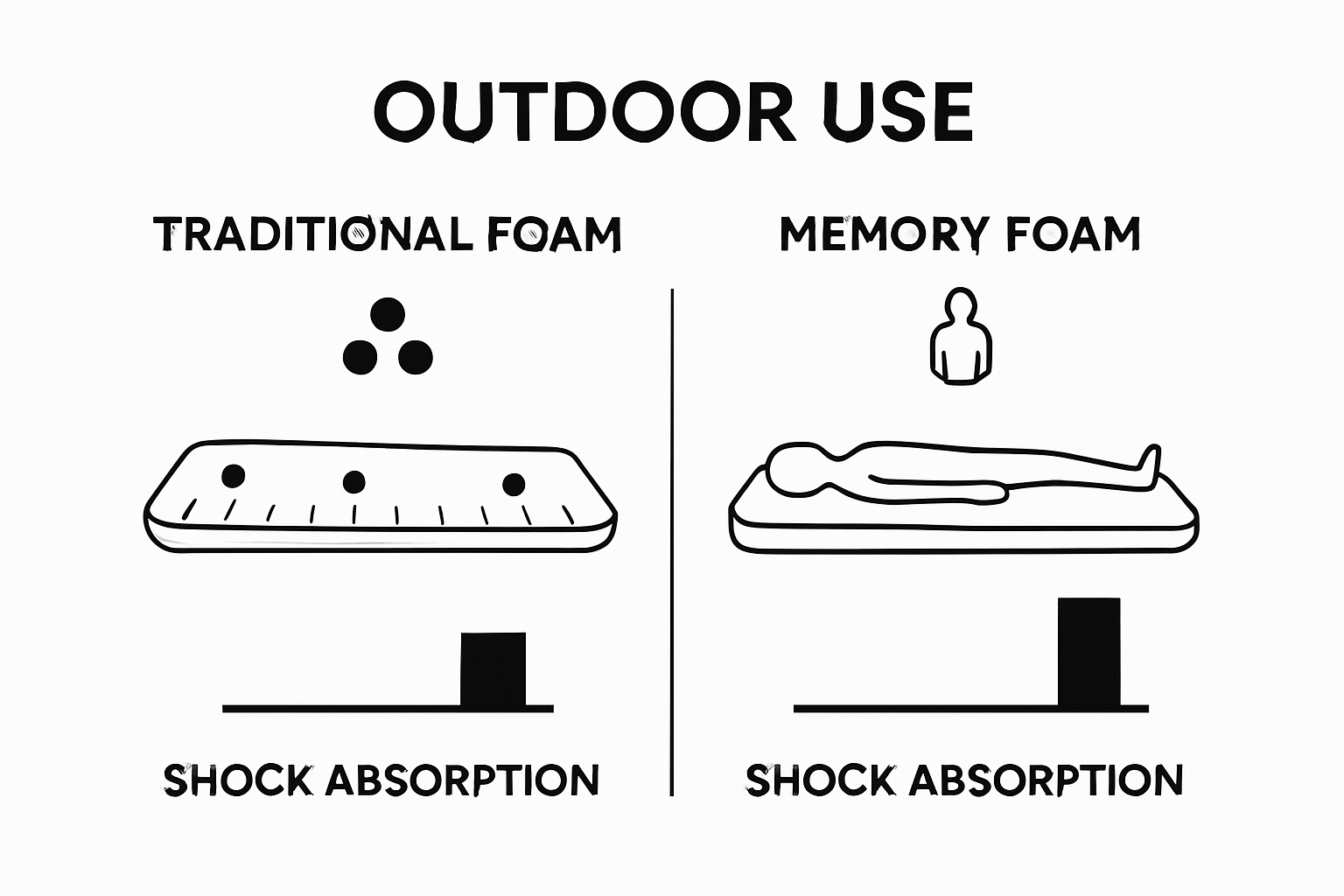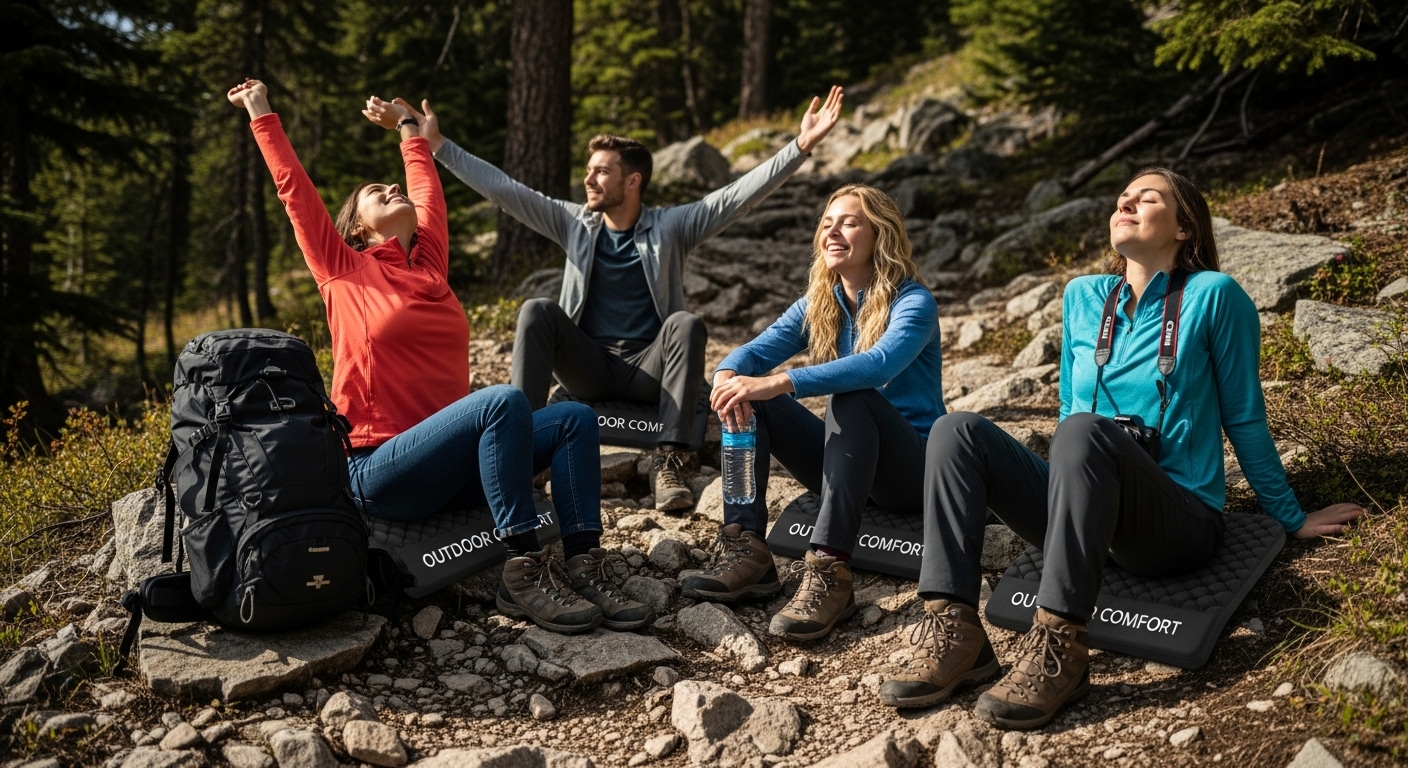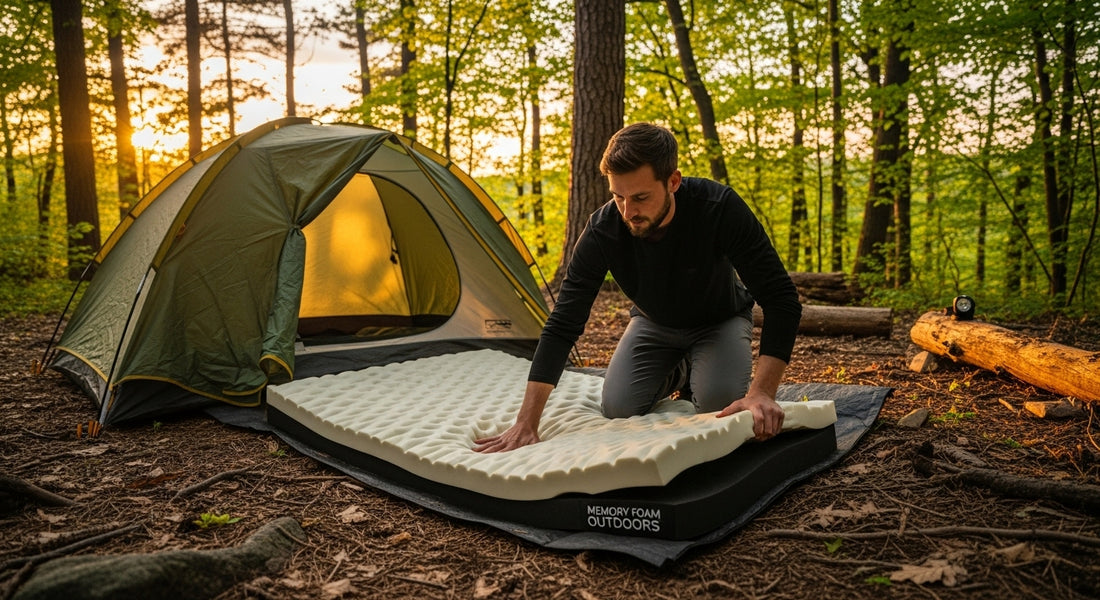Memory foam changed comfort forever when NASA first developed it in the 1960s. Most people think it is just for plush mattresses at home, but that is only scratching the surface. The real surprise is how memory foam’s viscoelastic magic works outdoors too and now it powers everything from sleeping pads to hiking gear by distributing body weight so well that campers report significantly reduced joint stress and muscle fatigue even on rocky terrain.
Table of Contents
- What Is Memory Foam And Its Basic Properties?
- Why Memory Foam Matters In Outdoor Settings
- How Memory Foam Provides Comfort And Support
- Key Applications Of Memory Foam In Outdoor Gear
- Real-World Impact Of Memory Foam On Outdoor Experiences
Quick Summary
| Takeaway | Explanation |
|---|---|
| Memory foam adapts to body shapes and weights | Its unique viscoelastic properties allow for customized support, improving comfort significantly during use. |
| Temperature sensitivity enhances comfort outdoors | Memory foam’s responsiveness to temperature maintains comfort, becoming pliable in warmth and firmer in cold. |
| Effective shock absorption for outdoor gear | Provides excellent energy distribution, reducing strain during activities on rough or uneven surfaces. |
| Facilitates better physical recovery after activities | Redistributes weight evenly, helping to minimize muscle fatigue and joint stress during outdoor pursuits. |
| Promotes psychological comfort in unpredictable environments | Its adaptability fosters a sense of assurance, contributing to a relaxed experience in challenging conditions. |
What is Memory Foam and Its Basic Properties?
Memory foam represents an innovative material originally developed by NASA in the 1960s, transforming how we experience comfort and support across various applications. This specialized polyurethane foam offers unique viscoelastic properties that make it extraordinary in responding to body temperature and pressure.
To better understand the unique attributes that make memory foam effective in both indoor and outdoor settings, here is a breakdown of its essential features and characteristics.
| Characteristic | Description |
|---|---|
| Even Weight Distribution | Spreads body weight uniformly across the contact surface, reducing pressure points. |
| Temperature Sensitivity | Reacts to heat and cold, becoming softer in warmth and firmer in cooler environments. |
| Viscoelasticity | Combines viscosity and elasticity to contour precisely to shapes and slowly recover. |
| Pressure Relief | Reduces pressure on joints and muscles for enhanced comfort and injury prevention. |
| Energy Absorption | Absorbs and disperses impact, making it ideal for shock absorption in gear. |
| Durability | Maintains resilience and support over repeated use and environmental exposure. |
| Slow Recovery | Gently returns to its original form after pressure, avoiding abrupt bounce-back. |
The Scientific Composition of Memory Foam
At its core, memory foam consists of polyurethane combined with additional chemicals that increase its density and viscosity. These chemical modifications create a material capable of remarkable shape-changing characteristics. When pressure or heat is applied, memory foam temporarily deforms to match the exact contours of an object or body part, then gradually returns to its original shape when the pressure is removed.
Key characteristics of memory foam include:
- Ability to distribute body weight evenly
- Temperature sensitivity that allows shape adaptation
- Slow recovery rate after pressure is released
- High energy absorption capabilities
How Memory Foam Functions
The fundamental mechanism of memory foam involves its viscoelastic nature. When you apply pressure, the foam’s molecules begin to spread out, creating a molding effect around the applied force. This unique behavior allows memory foam to provide customized support by responding to individual body shapes and weights.
According to NASA’s original research, the material was initially designed to improve seat cushioning and crash protection for astronauts. Its ability to absorb and redistribute energy makes it exceptional for applications requiring pressure relief and impact mitigation.
Memory foam’s performance depends on its density and composition. Higher density foams typically offer more support and durability, while lower density versions provide softer, more responsive experiences. The material’s temperature sensitivity means it becomes more pliable in warmer environments and firmer in cooler conditions, creating a dynamic comfort experience that adapts to its surroundings.
Why Memory Foam Matters in Outdoor Settings
Memory foam transcends indoor comfort, emerging as a revolutionary material with extraordinary potential in outdoor environments. Its unique properties make it an exceptional solution for adventurers seeking enhanced comfort, protection, and adaptability during outdoor experiences.
Performance in Challenging Outdoor Conditions
Outdoor settings demand materials that can withstand variable temperatures, uneven surfaces, and constant environmental changes. Memory foam excels in these challenging conditions by offering remarkable adaptability. Its viscoelastic properties allow it to conform to different terrains while providing consistent support and cushioning.
Key advantages of memory foam in outdoor settings include:
- Superior weight distribution across uneven surfaces
- Enhanced shock absorption for rough terrain
- Temperature adaptive performance
- Pressure point relief during extended outdoor activities
Thermal and Comfort Innovations
Memory foam’s temperature sensitivity becomes a strategic advantage in outdoor environments. In cooler conditions, the foam maintains structural integrity, while in warmer settings, it becomes more pliable. This dynamic response ensures consistent comfort across diverse environmental conditions.
Camping comfort experts recognize memory foam’s potential to transform outdoor sleeping experiences. Whether used in sleeping pads, portable mattresses, or specialized outdoor gear, the material provides unprecedented comfort and support.
Additionally, memory foam’s energy absorption capabilities make it invaluable for outdoor applications. Its ability to distribute weight evenly reduces physical strain during activities like hiking, camping, and backpacking. The material’s resilience ensures that outdoor enthusiasts can rest and recover effectively, minimizing discomfort from hard or uneven surfaces.
How Memory Foam Provides Comfort and Support
Memory foam represents a sophisticated material engineered to deliver unparalleled comfort and support through its unique molecular structure and responsive characteristics. By understanding its intricate mechanisms, outdoor enthusiasts can appreciate how this innovative material transforms physical experiences across various environments.
Pressure Distribution and Body Contouring
The fundamental mechanism of memory foam involves its ability to distribute body weight evenly and adapt to individual body shapes. When pressure is applied, the foam’s viscoelastic properties cause its molecules to spread out, creating a custom-molded surface that perfectly matches the user’s unique physical contours. This precision ensures minimal pressure points and maximum comfort.

Key comfort mechanisms include:
- Gradual molecular compression responding to body weight
- Uniform weight distribution across contact surfaces
- Adaptive response to individual body shapes
- Slow, controlled recovery after pressure is removed
Thermal Sensitivity and Support Dynamics
Memory foam’s temperature sensitivity plays a critical role in its comfort delivery. As body heat interacts with the material, it becomes more malleable, allowing deeper and more personalized contouring. This dynamic response means the foam provides different levels of support based on temperature, creating a responsive cushioning experience that adjusts in real time.
Outdoor mattress experts recognize that this thermal adaptability is particularly beneficial in variable outdoor environments. The material can maintain structural integrity in cooler temperatures while becoming more responsive in warmer conditions.
According to research in biomechanical engineering, memory foam’s unique molecular structure allows it to redistribute pressure systematically. This means reduced stress on specific body parts, minimized muscle tension, and enhanced overall comfort during extended periods of use. Whether supporting a hiker after a long day on the trail or providing cushioning during camping, memory foam transforms how we experience physical support in challenging outdoor settings.
Key Applications of Memory Foam in Outdoor Gear
Memory foam has revolutionized outdoor equipment design, transforming how adventurers experience comfort and protection in challenging environments. Its versatile properties make it an invaluable material across multiple outdoor gear categories, offering innovative solutions for performance and comfort.
Sleeping and Rest Equipment
In outdoor sleeping gear, memory foam provides unparalleled comfort and support. Sleeping pads, camping mattresses, and portable bedding benefit from its ability to conform to uneven terrain while distributing body weight evenly. The material’s shock absorption capabilities ensure that campers and hikers can rest comfortably on rocky, irregular surfaces without experiencing significant pressure points.
Critical applications in sleeping equipment include:
- Portable camping mattresses with adaptive support
- Compact sleeping pads for backpacking
- Insulated ground covers with pressure relief
- Lightweight sleeping bag inserts
Protective Gear and Equipment Padding
Memory foam’s shock absorption and energy distribution properties make it exceptional for protective outdoor gear. Backpack straps, helmet linings, and equipment cases leverage the material’s ability to reduce impact and provide customized cushioning. The foam’s capacity to mold to specific shapes ensures maximum protection and comfort during high-intensity outdoor activities.
Camp bedding experts recognize memory foam’s potential to enhance outdoor equipment performance. By integrating this material into various gear components, manufacturers can create products that offer superior comfort and protection.
The following table summarizes the main ways memory foam is applied in outdoor gear, outlining the intended purpose and key benefits for each category mentioned in the article.
| Application Type | Use Case Example | Key Benefit |
|---|---|---|
| Sleeping and Rest Equipment | Camping mattresses, sleeping pads | Comfort and even weight distribution on uneven terrain |
| Protective Equipment Padding | Helmet linings, knee pads, backpack straps | Shock absorption and custom-fit protection |
| Insulated Covers & Inserts | Sleeping bag inserts, ground covers | Pressure relief and thermal adaptability |
| Gear & Equipment Cases | Molded cases for outdoor electronics | Superior cushioning and energy dispersion |
| Footwear Protection | Hiking boots insoles, supportive inserts | Minimized fatigue from sustained activity and rugged surfaces |
According to NASA’s original research, memory foam was initially developed to improve impact protection, a characteristic that translates perfectly to outdoor gear applications. Whether used in hiking boots, protective knee pads, or specialized camping equipment, memory foam continues to push the boundaries of comfort and performance in outdoor environments.

Real-World Impact of Memory Foam on Outdoor Experiences
Memory foam has transformed outdoor experiences by providing unprecedented comfort, support, and adaptability across diverse environmental conditions. Its innovative properties extend far beyond traditional cushioning, delivering tangible benefits that directly enhance how adventurers interact with challenging outdoor environments.
Enhanced Physical Recovery and Performance
For outdoor enthusiasts, memory foam serves as a critical tool for physical recovery and performance optimization. By distributing body weight evenly and reducing pressure points, the material helps minimize muscle fatigue and joint stress during and after intense outdoor activities. Hikers, campers, and backpackers experience reduced physical strain, enabling longer and more comfortable expeditions.
Significant performance benefits include:
- Rapid muscle recovery after strenuous activities
- Reduced joint stress during extended outdoor trips
- Improved sleep quality in challenging terrains
- Minimized physical discomfort from uneven surfaces
Psychological Comfort and Environmental Adaptation
Beyond physical benefits, memory foam provides psychological comfort by creating a sense of stability and support in unpredictable outdoor settings. Its ability to adapt to temperature variations and terrain changes helps adventurers feel more secure and relaxed. The material’s responsive nature means equipment and sleeping surfaces continuously adjust to individual needs, creating a personalized comfort experience.
Camping sustainability experts recognize that memory foam’s adaptability contributes to more sustainable and enjoyable outdoor experiences. By reducing the need for multiple specialized equipment pieces, the material helps minimize environmental impact while maximizing user comfort.
According to scientific research on material performance, memory foam’s molecular structure allows it to maintain consistent performance across varying environmental conditions. This resilience means outdoor enthusiasts can rely on memory foam equipment to provide consistent comfort whether they are traversing desert landscapes, mountain trails, or forest environments.
Discover Unmatched Outdoor Comfort with Hazli Memory Foam Solutions
Outdoor adventures often come with uncomfortable nights, painful pressure points, and the struggle to get real rest on uneven ground. The article highlighted how memory foam adapts to your body and cushions every contour, even in challenging temperatures and unpredictable terrain. If you are tired of tossing and turning or waking up sore after a weekend of camping, it is time to experience the support and resilience that only true quality memory foam can deliver.

Why settle for less when you can rest on memory foam designed for the outdoors? Visit Hazli Collection and explore our range of memory foam camping mattresses and accessories created for campers who value comfort and durability. Dive into the details in our latest camping comfort guide or read about the real benefits of memory foam on the trail in our outdoor mattress feature. Take the next step now and transform your nights outside with gear built to keep you supported through every adventure.
Frequently Asked Questions
What is memory foam and how does it work in outdoor settings?
Memory foam is a specialized polyurethane foam that adapts to body shape and weight by distributing pressure evenly. In outdoor settings, its temperature-sensitive properties allow it to maintain comfort across varying environments, providing cushioning and support on uneven surfaces.
How does memory foam improve comfort during outdoor activities?
Memory foam improves comfort by contouring to the body, reducing pressure points, and distributing weight evenly. Its ability to absorb shock and provide customized support helps minimize muscle fatigue and joint stress, enhancing overall comfort during extended outdoor activities.
What are the benefits of using memory foam in outdoor sleeping gear?
Memory foam offers significant benefits in outdoor sleeping gear such as tents and portable mattresses by providing superior comfort and support. It adapts to uneven terrain, absorbs shock, and reduces pressure points, allowing for better sleep quality during camping and hiking trips.
Is memory foam suitable for all outdoor conditions?
Yes, memory foam is designed to perform well in various outdoor conditions. Its temperature sensitivity allows it to remain supportive in cooler environments while becoming more pliable in warmer settings, ensuring consistent comfort across different terrains and temperatures.
Recommended
- 7 Camping Comfort Hacks for a Great Outdoor Experience – Hazli Collection
- Camp Bedding Organization Guide: Optimize Your Outdoor Comfort – Hazli Collection
- Understanding Why Use Outdoor Mattresses for Comfort – Hazli Collection
- 8 Essential Camping Sustainability Tips for Nature Lovers – Hazli Collection

